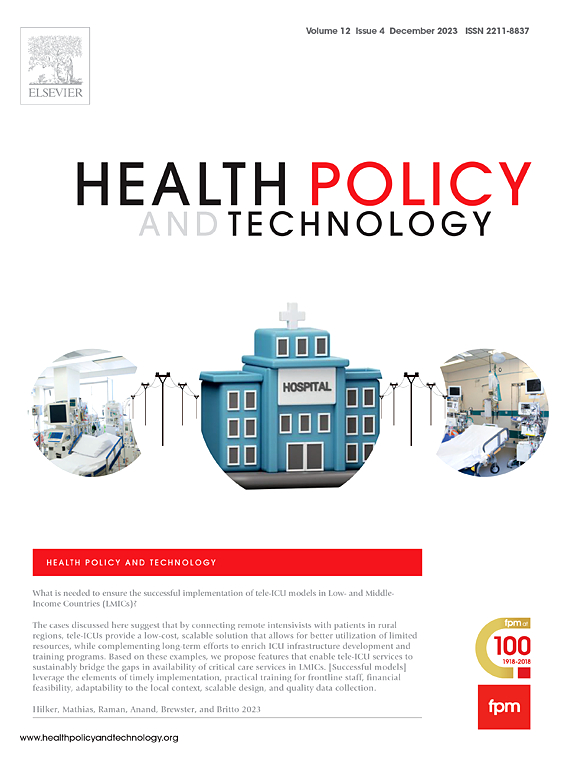古巴、西班牙、意大利和德国的医疗保健系统概况和大流行结果的多维缩放
IF 3.7
3区 医学
Q1 HEALTH POLICY & SERVICES
引用次数: 0
摘要
目的:本研究考察了古巴、西班牙、意大利和德国的基线健康风险与COVID-19死亡率轨迹的关系,并确定与更好结果相关的系统特征。虽然以前的比较研究强调国内生产总值水平或医院能力,但很少有研究系统地将基线健康风险和卫生系统模型与大流行轨迹联系起来;这项研究解决了这一差距。研究设计:利用可公开获得的二手数据,对四种截然不同的卫生系统模型进行跨国观察研究(古巴:国家社会主义;西班牙/意大利:地中海福利国家;德国:社团主义俾斯麦)。方法:我们在两个互补的阶段应用多维尺度(MDS):(i)基线健康指标(BHI, 8个大流行前变量)的横断面图,(ii)使用相关距离绘制基于轨迹的大流行轨迹指标(PTM,每月报告的指标,2020-2023)图。结果:BHI阶段显示出不同的大流行前配置:古巴在心血管死亡率和男性吸烟方面较高;西班牙女性吸烟率上升;意大利老龄结构和人口密度较高;和德国糖尿病患病率较高的人口压力。在PTM阶段,古巴的COVID-19累计死亡率在四个国家中最低(每百万人死亡776人),而欧洲国家的死亡率为每百万人死亡2070-3261人。结论:两阶段设计阐明了基线风险概况与大流行轨迹的关系。古巴和欧洲的分离在摄动下是稳定的,而欧洲内部的距离则变化较大;因此,我们没有对意大利、西班牙和德国进行排名。欧洲病例之间的可分离性降低与其卫生系统中日益增长的金融化/市场化和政策趋同是一致的,这可能会压缩交付和流行病应对方面的结构性差异,从而在我们的样本量和分辨率上限制了PTM领域的歧视。本文章由计算机程序翻译,如有差异,请以英文原文为准。
Multi-dimensional scaling of healthcare system profiles and pandemic outcomes in Cuba, Spain, Italy, and Germany
Objectives:
This study examines how baseline health risks in Cuba, Spain, Italy, and Germany relate to COVID-19 mortality trajectories and to identify system features associated with better outcomes. While previous comparative studies have emphasized GDP levels or hospital capacity, few have systematically linked baseline health risks and health-system models to pandemic trajectories; this study addresses that gap.
Study design:
Cross-country observational study of four contrasting health system models using publicly available secondary data (Cuba: state-socialist; Spain/Italy: Mediterranean welfare states; Germany: corporatist Bismarckian).
Methods:
We applied Multi-Dimensional Scaling (MDS) in two complementary stages: (i) a cross-sectional map of Baseline Health Indicators (BHI; eight pre-pandemic variables), and (ii) a trajectory-based map of Pandemic Trajectory Metrics (PTM; monthly reported indicators, 2020–2023) using correlation distance.
Results:
The BHI stage revealed distinct pre-pandemic configurations: Cuba separated on higher cardiovascular mortality and male smoking; Spain on elevated female smoking; Italy on older age structure and higher population density; and Germany on demographic pressures with higher diabetes prevalence. In the PTM stage, Cuba recorded the lowest cumulative COVID-19 mortality among the four (776 deaths per million), whereas European countries reached 2070–3261 deaths per million.
Conclusions:
The two-stage design clarifies how baseline risk profiles relate to pandemic trajectories. The Cuba–Europe separation is stable under the perturbations examined, while within-Europe distances are more variable; accordingly, we refrain from ranking Italy, Spain, and Germany. Reduced separability among the European cases is consistent with increasing financialization/marketisation and policy convergence in their health systems, which may compress structural differences in delivery and epidemic response and thus limits discrimination in the PTM space at our sample size and resolution.
求助全文
通过发布文献求助,成功后即可免费获取论文全文。
去求助
来源期刊

Health Policy and Technology
Medicine-Health Policy
CiteScore
9.20
自引率
3.30%
发文量
78
审稿时长
88 days
期刊介绍:
Health Policy and Technology (HPT), is the official journal of the Fellowship of Postgraduate Medicine (FPM), a cross-disciplinary journal, which focuses on past, present and future health policy and the role of technology in clinical and non-clinical national and international health environments.
HPT provides a further excellent way for the FPM to continue to make important national and international contributions to development of policy and practice within medicine and related disciplines. The aim of HPT is to publish relevant, timely and accessible articles and commentaries to support policy-makers, health professionals, health technology providers, patient groups and academia interested in health policy and technology.
Topics covered by HPT will include:
- Health technology, including drug discovery, diagnostics, medicines, devices, therapeutic delivery and eHealth systems
- Cross-national comparisons on health policy using evidence-based approaches
- National studies on health policy to determine the outcomes of technology-driven initiatives
- Cross-border eHealth including health tourism
- The digital divide in mobility, access and affordability of healthcare
- Health technology assessment (HTA) methods and tools for evaluating the effectiveness of clinical and non-clinical health technologies
- Health and eHealth indicators and benchmarks (measure/metrics) for understanding the adoption and diffusion of health technologies
- Health and eHealth models and frameworks to support policy-makers and other stakeholders in decision-making
- Stakeholder engagement with health technologies (clinical and patient/citizen buy-in)
- Regulation and health economics
 求助内容:
求助内容: 应助结果提醒方式:
应助结果提醒方式:


